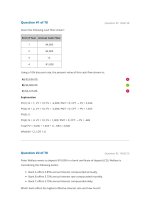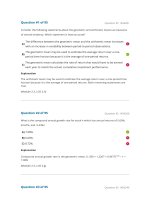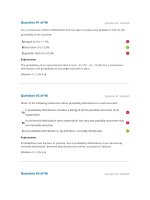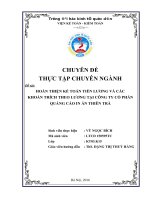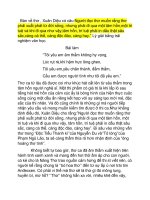Efl students’ difficulties in reading academic tasks
Bạn đang xem bản rút gọn của tài liệu. Xem và tải ngay bản đầy đủ của tài liệu tại đây (581.41 KB, 111 trang )
MINISTRY OF EDUCATION AND TRAINING
QUY NHON UNIVERSITY
TRỊNH THỊ HUYÊN
EFL STUDENTS’ DIFFICULTIES IN READING
ACADEMIC TASKS
Field: Theory and Methodology of English Language Teaching
Code: 8140111
SUPERVISOR: LÊ NHÂN THÀNH, PhD
BỘ GIÁO DỤC VÀ ĐÀO TẠO
TRƢỜNG ĐẠI HỌC QUY NHƠN
TRỊNH THỊ HUYÊN
NHỮNG KHÓ KHĂN CỦA HỌC SINH TRONG CÁC
LOẠI BÀI TẬP ĐỌC HIỂU TIẾNG ANH
Ngành: Lý luận và phƣơng pháp dạy học bộ môn Tiếng Anh
Mã số: 8140111
NGƢỜI HƢỚNG DẪN: TS. LÊ NHÂN THÀNH
i
STATEMENT OF ORIGINAL AUTHORSHIP
The work contained in this thesis has not previously been submitted for
a degree or diploma in any university. I certify that, to the best of my
knowledge and belief, my thesis contains no material previously published or
written by any other person except where due reference is made in the thesis
itself.
Date:
Signed:
Trinh Thi Huyen
ii
ACKNOWLEDGEMENTS
This paper could not have been completed without the encouragement
and support from several individuals and groups to whom I would like to
express my deep sense of gratitude during the stressful time of writing this
paper.
First and foremost, I am deeply grateful to my supervisor, Dr. Le Nhan
Thanh, for his support, patience, and encouragement throughout my study.
His technical and editorial advice was essential to the completion of this paper
and has taught me innumerable lessons and insights on the workings of
academic research in general. I have been extremely lucky to have a
supervisor who cared so much about my work.
My sincere thanks also go to the teachers at the Department of Foreign
Languages, Quy Nhon University for the useful knowledge that they taught
me during the time I attended the M.A course.
I would also like to thank the teachers and students at Ly Tu Trong
school for their untiring supports to this research paper. Without their
passionate participation and input, the study could not have been successfully
conducted.
Last but not least, I owe an unpaid debt to all the generous support,
love, and care from my beloved families and friends, which has given me
more strength, belief, and motivation to overcome all the troubles in the
whole process of this research.
Finally, I offer my regards and blessing to all of those who supported
me in the completion of the thesis.
iii
ABSTRACT
Reading comprehension is an important skill in learning English
because students with poor reading comprehension often face academic
challenges. In order to help students acquire good reading competence at
school, it is essential to find out what difficulties they face in reading
comprehension tasks. Therefore, this study aims to explore difficulties that
secondary school students encounter in their English reading comprehension
tasks by investigating their perceptions of the causes of the difficulties. The
study was conducted at Ly Tu Trong Secondary School, Gia Lai Province
with the participation of 90 students. The data for this study was collected
through questionnaires and 12 semi-structured interviews. Among eight
groups of factors, including both linguistic or non-linguistic factors, poor
grammar knowledge was perceived as the factor causing most difficulties for
the students in their reading comprehension tasks, followed by lack of content
knowledge, lack of vocabulary, lack of background knowledge, and lack of
reading strategies. In contrast, non-linguistic factors including psychological
factors, institutional factors, and physical factors were not perceived as the
causes for difficulties with reading comprehension tasks. The results from the
analysis of the interviews supported those from the questionnaires. They
affirmed that lack of vocabulary, grammar knowledge, background
knowledge, content knowledge, and reading strategies were the major causes
of difficulties for the students in doing reading comprehension tasks. Based
on the findings, implications for educators, school administrators, and EFL
teachers are addressed, and further studies are suggested.
iv
TABLE OF CONTENTS
STATEMENT OF ORIGINAL AUTHORSHIP ............................................... i
ACKNOWLEDGEMENTS .............................................................................. ii
ABSTRACT ..................................................................................................... iii
LIST OF ABBREVIATIONS ........................................................................... v
LIST OF TABLES ........................................................................................... vi
LIST OF FIGURES.......................................................................................... vi
CHAPTER 1. INTRODUCTION .................................................................. 1
1.1.BACKGROUND OF THE STUDY ....................................................... 1
1.2.RATIONALE FOR THE STUDY .......................................................... 3
1.3.AIM AND OBJECTIVES OF THE STUDY ......................................... 4
1.3.1. Aim of the study ........................................................................... 4
1.3.2. Objectives of the study ................................................................. 5
1.4.RESEARCH QUESTIONS .................................................................... 5
1.5.SCOPE OF THE STUDY ....................................................................... 5
1.6.SIGNIFICANCE OF THE STUDY ....................................................... 5
1.7.ORGANIZATION OF THE STUDY ..................................................... 6
CHAPTER 2. LITERATURE REVIEW ...................................................... 7
2.1.READING AND READING COMPREHENSION ............................... 7
2.2.THE IMPORTANCE OF READING COMPREHENSION ............... 10
2.3.TYPES OF READING ......................................................................... 12
2.4.READING
DIFFICULTIES
AND
FACTORS
INFLUENCING
READING DIFFICULTIES ....................................................................... 16
2.4.1. Reading difficulties ..................................................................... 16
2.4.2. Factors influencing reading difficulties ...................................... 17
2.4.3. Previous studies .......................................................................... 30
2.4.4. Research gaps ............................................................................. 34
2.5.SUMMARY .......................................................................................... 34
v
CHAPTER 3. METHODOLOGY ............................................................... 35
3.1.RESEARCH APPROACH ................................................................... 35
3.2.RESEARCH SETTING AND PARTICIPANTS ................................. 36
3.3.DATA COLLECTION INSTRUMENTS ............................................ 37
3.3.1. Questionnaires ............................................................................ 38
3.3.2. Interviews .................................................................................... 40
3.4.DATA COLLECTION PROCEDURES .............................................. 41
3.4.1. Administering the questionnaires ............................................... 41
3.4.2. Administering the interviews ...................................................... 42
3.5.DATA ANALYSIS METHODS .......................................................... 43
3.6.RESEARCH RELIABILITY AND VALIDITY .................................. 44
3.7.LEGAL AND ETHICAL CONSIDERATIONS .................................. 45
3.8.SUMMARY .......................................................................................... 45
CHAPTER 4. FINDINGS AND DISCUSSIONS ....................................... 47
4.1.RESULTS FROM THE QUESTIONNAIRES..................................... 47
4.1.1. Difficulties caused by linguistic factors ..................................... 49
4.1.2. Difficulties caused by non-linguistic factors .............................. 51
4.2.RESULTS FROM THE INTERVIEW ................................................. 57
4.3.DISCUSSIONS ..................................................................................... 60
4.3.1. Discussion of difficulties caused by linguistic factors ............... 60
4.3.2. Discussion of difficulties caused by non-linguistic factors ........ 62
4.4.SUMMARY .......................................................................................... 65
CHAPTER 5. CONCLUSION AND IMPLICATIONS ........................... 67
5.1.SUMMARY OF MAIN FINDINGS .................................................... 67
5.2.RESEARCH IMPLICATIONS ............................................................ 68
5.2.1. Implications for students............................................................. 68
5.2.2. Implications for school administrators ....................................... 71
5.2.3. Implications for teachers ............................................................. 71
vi
5.3.LIMITATIONS OF THE STUDY........................................................ 72
5.4.RECOMMENDATIONS FOR FURTHER STUDIES ........................ 73
REFERENCES .............................................................................................. 75
APPENDICES
v
LIST OF ABBREVIATIONS
EFL: English as a Foreign Language
FL: Foreign language
L1: First Language
L2: Second Language
SPSS: Statistical Package for Social Sciences
vi
LIST OF TABLES
Table 3.1. Background information of the participants .................................. 37
Table 3.2. Process of conducting the survey ................................................... 39
Table 3.3. Mean Range for Agreement Degree .............................................. 44
Table 3.4. Reliability Statistics ....................................................................... 45
Table 4.1. Students‟ perceptions towards causes of difficulties in reading
comprehension tasks ....................................................................................... 47
Table 4.2. A comparison between linguistic and non- linguistic factors........ 56
LIST OF FIGURES
Figure 3.1. Quantitative data collection procedure ......................................... 42
Figure 3.2. Qualitative data collection procedure ........................................... 43
1
CHAPTER 1. INTRODUCTION
To establish the space for the topic and research questions for the study,
this chapter starts with an overview of reading comprehension and difficulties
of reading comprehension students face in the world and Vietnam context. It
then describes the rationale for the study, the research aims and objects, and
research questions. This is followed by the scope and the significance of the
study. Finally, there is an overview of the organization of the study.
1.1.
BACKGROUND OF THE STUDY
Nowadays, together with growth of global connection, English has
recently been paid attention to as it is the language of era and science. The
most important skill among the four language skills lies on reading as it can
improve the overall language proficiency (Snow, Burns & Griffin, 1998;
McDonough
&
Shaw,
2003;
Krashen
&
Brown,
2007).
More
comprehensively, reading plays a central role in our educational, working,
recreational and social lives. The ability to read is highly valued and
important for social and economic advancement. A student may have no
reading difficulty in his or her mother tongue. The problem exerts when
reading is applied to a second language, as students might be lagging behind
in a number of reading components, including accuracy, comprehension, and
speed. As Alsamadani (2008) mentioned, lagging behind is a cognitive
difficulty associated with the process of reading in another language. In other
words, these difficulties are more likely to be associated with the nature of the
language or even sociocultural aspects. All models of comprehension
recognize the need for readers to build up a mental representation of text, a
process that requires integration across a range of sources of information,
from lexical features to knowledge concerning events in the world (e.g.,
Garnham, 2001; Gernsbacher, 1990; Kintsch, 1998).
2
Researchers mentioned that the ability to read is crucial for children‟s
future academic, economic, and social success (Norton & Wolf, 2012;
Olitskey & Nelson, 2003; Snow, Burns, & Griffen, 1998). A majority of
children are able to learn to read with ease, and have average reading ability
that
is
characterized
by
fluent
word
identification
and
adequate
comprehension (Vellutino & Fletcher, 2005). However, 10% to 15% of
English speaking school-aged children have reading difficulties (Shaywitz &
Shaywitz, 2008; Snow et al., 1998; Vellutino & Fletcher, 2005; Vellutino et
al., 2004).
Reading comprehension is the process of constructing meaning by
coordinating a number of complex processes that include word reading, word
and world knowledge, and fluency (Harris & Graham, 2007). Readers
comprehend a text when they are able to communicate with a text. They are
able to draw the information from written text and interpret this information
appropriately. In other words, reading comprehension is a kind of interaction
between the readers and the text through written symbol in order to grasp the
information from written text.
The importance of reading comprehension is really realized by the
government to make a policy in educational system; reading as one of the four
language skills must be taught for the students in the classroom (Tran Quoc
Thao & Duong My Tham, 2018)
Many academics agree that reading comprehension is not simply
recognizing individual words, or even understanding each individual word as
our eyes pass over it. Due to the reason, exploring the difficulties students
face in reading tasks is an iportant part of to understand the current problems.
In the Vietnamese context, teaching and learning English is brought up
as a top concern, especially in the current period of international integration
3
(Le Ha Van, 2021; Tran Quoc Thao & Duong My Tham, 2018). Therefore,
English has been included in the national education curriculum and has
become a compulsory subject in schools from primary school to university
level. In addition, reading comprehension plays an important role in human
life. Its role is realized as very substantial because it opens up new knowledge
for individual. The goal is to gain information from what the writer conveys
through a text, to use this information to enrich his/her experiences, and to
improve his/her intellectual ability.
In Vietnam, there are two reasons explaining why the young generation
seems to read less and less. The first reason is that they suffer pressure from
school work and the second reason is that there are many obstacles and
difficulties which reduce interest of the youth in reading book. Students seem
to be distracted from reading because of the outside environment such as
noisy friends, noisy school, and so on. For such reasons, reading
comprehension should be highly recommended in every school especially in
secondary school.
1.2.
RATIONALE FOR THE STUDY
Learning English seems to be one of main tasks of students from
kindergarten to university. In this process, they encounter a large number of
difficulties. As we know, if vocabulary is at the heart of developing
proficiency and achieving competency in language skills, reading is one of the
most important skills helping language learners improve language proficiency
in language learning and retention in every aspect. Many authors affirm that
although reading is of great significance among four basic language skills,
many students encounter problems in their reading comprehension (Snow,
Burns & Griffin, 1998; McDonough & Shaw, 1993; Krashen & Brown,
2007).
4
As we know, the success of language learner is largely influenced by
his/ her reading practice. The role of reading in language proficiency is
explained by Harmer (2007) who states: “Reading is useful for language
acquisition and the more they read, the better they get…Reading also has a
positive effect on students‟ vocabulary knowledge, on their spelling and their
writing” (p. 157). The problem is that few studies were conducted in the field
of exploring issues and challenges facing secondary school students in
Vietnam. In addition, the land of Gia Lai province today is the long- standing
residence of the Jrai (33,5%) and Bahnar (13,7%) ethnic groups who have a
few chances to study English since primary school so they usually face
difficulties in every aspect of English in general and in reading specifically. In
fact, we have all taught many students who do not understand whatever they
read, and we struggle with ways to increase their reading and comprehension
skills. Thus, the students‟ reading acquisition and reading retention need to be
enhanced.
Consequently, to fill the literature gap concerning Vietnamese lower
secondary school students‟ difficulties with reading comprehension tasks and to
find out the measures to enable them to tackle these difficulties, the study aims at
exploring difficulties that lower secondary school students encounter in doing
reading comprehension tasks and causes of difficulties at Ly Tu Trong
Secondary School, Gia Lai.
1.3.
AIM AND OBJECTIVES OF THE STUDY
1.3.1. Aim of the study
The overarching aim is exploring difficulties that lower secondary
school students encounter in doing reading comprehension tasks and factors
explaining these difficulties.
5
1.3.2. Objectives of the study
To achieve this aim, the objectives of this study are as follows:
1)
To examine the difficulties that EFL students encounter in
English reading comprehension tasks, and
2)
To investigate EFL students‟ perceptions of causes of the
difficulties that they encounter in their English reading comprehension tasks.
1.4.
RESEARCH QUESTIONS
This study considers the following research questions:
1)
What difficulties do EFL students encounter in their English
reading comprehension tasks?
2)
What do EFL students consider as causes of the difficulties that
they encounter in their English reading comprehension tasks?
1.5.
SCOPE OF THE STUDY
The research was carried out with the participation of 90 EFL students
who were students at Li Tu Trong Secondary School, Thang Loi Ward, Pleiku
city, Gia Lai province to find out students‟ difficulties in doing reading tasks
and their perceptions about causes of these difficulties.
1.6.
SIGNIFICANCE OF THE STUDY
Concerning the aforementioned research objectives, this study
hopefully can give some contributions as follows:
In theory, the study will be beneficial in building a knowledge base of
lower secondary school students‟ perceptions of the difficulties they face in
academic reading tasks at school. The research is intended to shed light on
students‟ perceptions of the difficulties of students in doing reading
comprehension tasks and which factors explain these difficulties. Therefore,
6
the research findings will provide important insights into looking at the
reading comprehension tasks as an effective instructional means in the
teaching- learning process, which helps students overcome common problems
in long- reading process of many tasks at school.
In practice, a better understanding of the difficulties that students face
may serve a guide for different stakeholders, including policy- makers,
decision- makers, educators, and teachers to make learning reading become
more effective, informative, applicable and enjoyable.
Finally, the findings of this research can act as a useful source of
reference for future researchers who are interested in the field of reading
comprehension tasks in English teaching- learning process.
1.7.
ORGANIZATION OF THE STUDY
The research consists of five chapters. Chapter 1, introduction, gives a
brief introduction about the background of the research, rationale, aim and
objectives, research questions, scope, and significance as well as the structure
of the thesis.
Chapter 2, literature review, provides a fundamental overview of literature
surrounding reading comprehension tasks and difficulties students face in teaching
foreign languages as well as connects relevant studies to this study.
Chapter 3, methodology, describes methods of the research,
participants, instruments, and procedure of data collection as well as data
analysis.
Chapter 4, findings and discussion, illustrates and analyzes the data
collected to provide the answers to the research questions.
Chapter 5, conclusion and implications, summarizes the results of the
study and gives some implications and suggestions for further research.
7
CHAPTER 2. LITERATURE REVIEW
This chapter provides an in-depth analysis of the arguments and
concepts of EFL reading comprehension and related issues like reading and
reading comprehension, reading difficulties, and factors attributed to reading
difficulties. This review critically analyses key approaches and views about
EFL reading comprehension in line with the research objectives set by this
study. This chapter also aims to identify any gaps within the literature that
motivates the researcher to perform the current study.
2.1.
READING AND READING COMPREHENSION
The proliferation of reading comprehension research has generated
many definitions and provided many interesting ideas on which many authors
seem to agree. In the past and present, authors define reading comprehension
based on their beliefs about the process of reading. Thus, the definitions of
reading comprehension lie either under the bottom-up approach or under topdown approach to reading.
Some linguists such as Gough (1972) and Carroll (1964) regarded
reading as a passive decoding process (bottom-up): graphemes are perceived
as forming words, words as forming sentences, and sentences as forming
paragraphs and so on. Grabe and Stoller (2002) also indicate that reading
comprehension is processing words, forming a representation of general main
ideas, and integrating it into a new understanding. Another definition of
reading is mentioned by Clapham (2009, p. 11) where reading is viewed as
“the ability to make sense of written or printed symbols. The reader uses the
symbols to guide the recovery of the information from his or her memory and
subsequently uses this information to construct a plausible interpretation of
the writer‟s message”.
8
On the other hand, other linguists such as Goodman (1976) and Smith
(1971) argue that the process of reading is a “top-down” one in which the
reader starts with a general idea (schema) of what should be in the text. This
is derived from the previously acquired knowledge by the reader who uses
this schema in perceiving and in interpreting graphic cues. Hudson (2007, p.
38) also gives a definition that associates reading with a top-down approach
where it is claimed that “reading is a selective process. It involves partial use
of available minimal language cues selected from perceptual input on the
basis of the reader's expectation”. Klingner et al. (2007) also argue that as a
process of constructing meaning, reading can be achieved through dynamic
instruction using the following aspects: the reader‟s prior knowledge, the
information suggested by the text, and the context of the reading situation.
Reading involves at least two people: the writer and the reader. The
reader has to decode the writer's words to understand his/her message and
construct meaning from text. Definitions of reading often include the concept
of understanding or comprehension. A number of researchers such as Lipka
and Siegel (2012), Russell (2013), McLean (2014), Turkyılmaz et al. (2014)
and Akyol et al. (2014) emphasize that the main goal of reading is
comprehension. Reading without comprehension is pointless. Grabe (2009, p.
14) states that “reading is centrally a comprehending process”. Readers read
to understand what is intended to be conveyed in writing. Ahmadi et al.
(2013, p. 238) refer to reading comprehension as “the ability of readers to
understand the surface and the hidden meanings of the text using metacognitive reading strategies”. Reading comprehension is “the process of
unlocking meaning from connected text” (Zoghi et al., 2010, p. 439).
According to Yogurtcu (2013, p. 376), “the process of reading comprehension
provides a link between thinking, textual content, and the reader‟s level of
9
readiness, expectations and objectives of reading”. Reading comprehension
from a psychological viewpoint as mentioned by Rivers (2000, p. 70) is “a
problem-solving behavior that actively involves the reader in the process of
deriving and assigning meaning [...] drawing on contextual information [...]
Readers decode print semantically and syntactically”. In line with this
definition, Russell (2013, p. 7) asserts that “it requires the reader to develop
an efficient system for solving problems during reading. The reading process
requires intentional thinking and reflecting”. In other words, to understand a
text efficiently requires the reader to be critical and reflective.
Snowling and Hulme (2005) identify three levels of understanding in
the comprehension process: word level, sentence level and text level. Browne
(2004) explains that word-level skills include phonic and graphic knowledge
and words recognition, sentence-level skills include grammatical knowledge,
and text-level skills include contextual understanding. According to Nuttall
(2005, p. 21), every sentence used in a text has four kinds of meaning:
“conceptual, propositional, contextual and pragmatic”. The conceptual
meaning is “the meaning a word can have on its own”; the propositional
meaning is “the meaning a sentence can have on its own”; the contextual
meaning is “the meaning a sentence can have only when in context”; and the
pragmatic meaning is “the meaning a sentence has only as part of the
interaction between writer and reader”. Each one of these levels of meanings
is important to guarantee reading comprehension.
Brantmeier (2003, p.4) claims that there “is not one true
comprehension, but a range of comprehension”. Day and Park (2005) classify
reading comprehension into six different types of comprehension that can
work together in parallel and/or in a linear fashion: literal comprehension,
reorganization, inference, prediction, evaluation, and personal response.
10
Literal comprehension is understanding the direct meaning of the text, which
means that any answers to questions coming from a text would be explicitly
outlined in the reading. Reorganization occurs when readers find various
pieces of information from a reading and combine them for additional
understanding. In this way, readers still use literal comprehension, but it is
applied to several areas of text in order to answer more specific questions
related to the text. Inference requires learners to go a step beyond literal
understanding and to combine and use their own knowledge in order to come
up with answers to implicitly stated information. Prediction combines a
reader‟s prior knowledge with his or her understanding of a passage in order
to guess what happens next; but it must be supported by the text in order to be
valid. Evaluation requires a learner to have a general knowledge of the topic
of a text and an understanding of the reading material so as to give judgment
or opinion about the text. Personal response is an open-ended type of
comprehension used by readers in order to provide their feelings about the
topic.
To sum up, reading comprehension is the process of extracting idea
within a text to get the overall understanding of a text rather than to get the
word by word meaning. The comprehension depends very much on the
reader, text and situation, where prior knowledge is crucial to give impact on
building the meaning on this process as it is constructed within the reader‟s
head (Woolley, 2011).
2.2.
THE IMPORTANCE OF READING COMPREHENSION
English is widely recognized as the universal language across the
world. It is also significant for students‟ academic success (Azeroual, 2013)
and has become essential in higher education (Najeeb, 2013). Reading is
associated with academic success (Logan et al., 2011; Dabarera et al., 2014)

